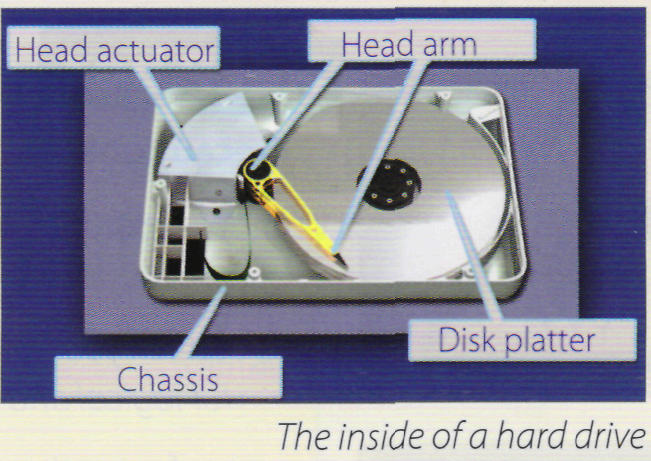
- •Contents
- •Unit 1 What is a computer? The role of a computer in our life. Reading and comprehension
- •Vocabulary
- •Unit 2 Types of computer systems reading and comprehension
- •Vocabulary
- •Types of mini computers
- •Presentation activity
- •Unit 3 Computer system reading and comprehension
- •Hz is for hertz
- •Vocabulary
- •Presentation activity
- •Unit 4 Data storage. Types of computer memory. Reading and comprehension
- •Text 1 What is Computer Memory?
- •Cache memory
- •Hard drive
- •Virtual memory
- •Protected memory
- •Text 2 Magnetic Storage
- •Optical discs and drives
- •Flash memory
- •Data storage
- •K. M, and g are numbers
- •B is for byte
- •Bps is for "bits per second"
- •Vocabulary
- •Presentation activity
- •Unit 5 Output devices reading and comprehension
- •Text 1 Displays
- •Text 2 Types of printers
- •Vocabulary
- •Presentation activity
- •Writing
- •Unit 6 Input devices reading and comprehension
- •Input devices
- •Text 2 Pointing devices The mouse
- •Pointer and cursor
- •Other pointing devices
- •Vocabulary
- •Mouse actions
- •Presentation activity
- •Writing
Text 2 Magnetic Storage
Magnetic storage devices store data by magnetizing particles on a disk or tape.
A
floppy
disk is
so called because it consists of a flexible sheet of plastic, coated
with iron oxide – a magnetizable material. A floppy disk drive
spins at 360 revolutions per minute (rpm), so it's relatively slow.
However, a hard
drive spins
at over 7,200 rpm and stores data on a stack of metal rotating disks
called platters.
This
means you can store much more data and retrieve information much
faster.
New disks need to be formatted before you can use them, unless they come preformatted from the manufacturer. When the disk is formatted, the operating system (OS) organizes the disk surface into circular tracks and divides each track into sectors. The OS creates a directory which will record the specific location of files. When you save a file, the OS moves the read/write head of the drive towards empty sectors, records the data and writes an entry for the directory. Later on, when you open that file, the OS looks for its entry in the directory, moves the read/write heads to the correct sector, and reads the file in the RAM area. However, formatting erases any existing files on a disk, so do not format disks on which data that you don't want to lose is stored.
The OS allows you to create one or more partitions on your hard drive, in effect dividing it into several logical parts. Partitions let you install more than one operating system (e.g. Windows and Linux) on your computer. You may also decide to split your hard drive because you want to store the OS and programs on one partition and your data files on another; this allows you to reinstall the OS when a problem occurs, without affecting the data partition.
The average time required for the read/write heads to move and find data is called seek time (or access time) and it is measured in milliseconds (ms); most hard drives have a seek time of 7 to 14 ms. Don't confuse this with transfer rate - the average speed required to transmit data from the disk to the CPU, measured in megabytes per second.
How to protect your hard drive
Don’t hit or move the computer while the hard drive is spinning. Hard drives are very sensitive to vibration and shocks, especially when they are operating; when the read/write head touches the rotating disk, it can scratch and damage the disk surface. This is known as head crash.
You shouldn't turn your computer off and on quickly. Wait at least ten seconds to ensure that the drive has stopped spinning.
Check your hard drive regularly for logical and physical errors. To check and repair a drive, you can use a disk diagnosis utility like Windows ScanDisk.
To minimize the risk of data loss or corruption, you should install an up-to-date virus scanner. You should also back up your hard drive regularly.
The future of hard drives may be hybrid hard drives. Hybrid hard drives combine a magnetic hard disk and flash memory into one device. This allows computers to boot, or start, more quickly, and also reduces power consumption.
